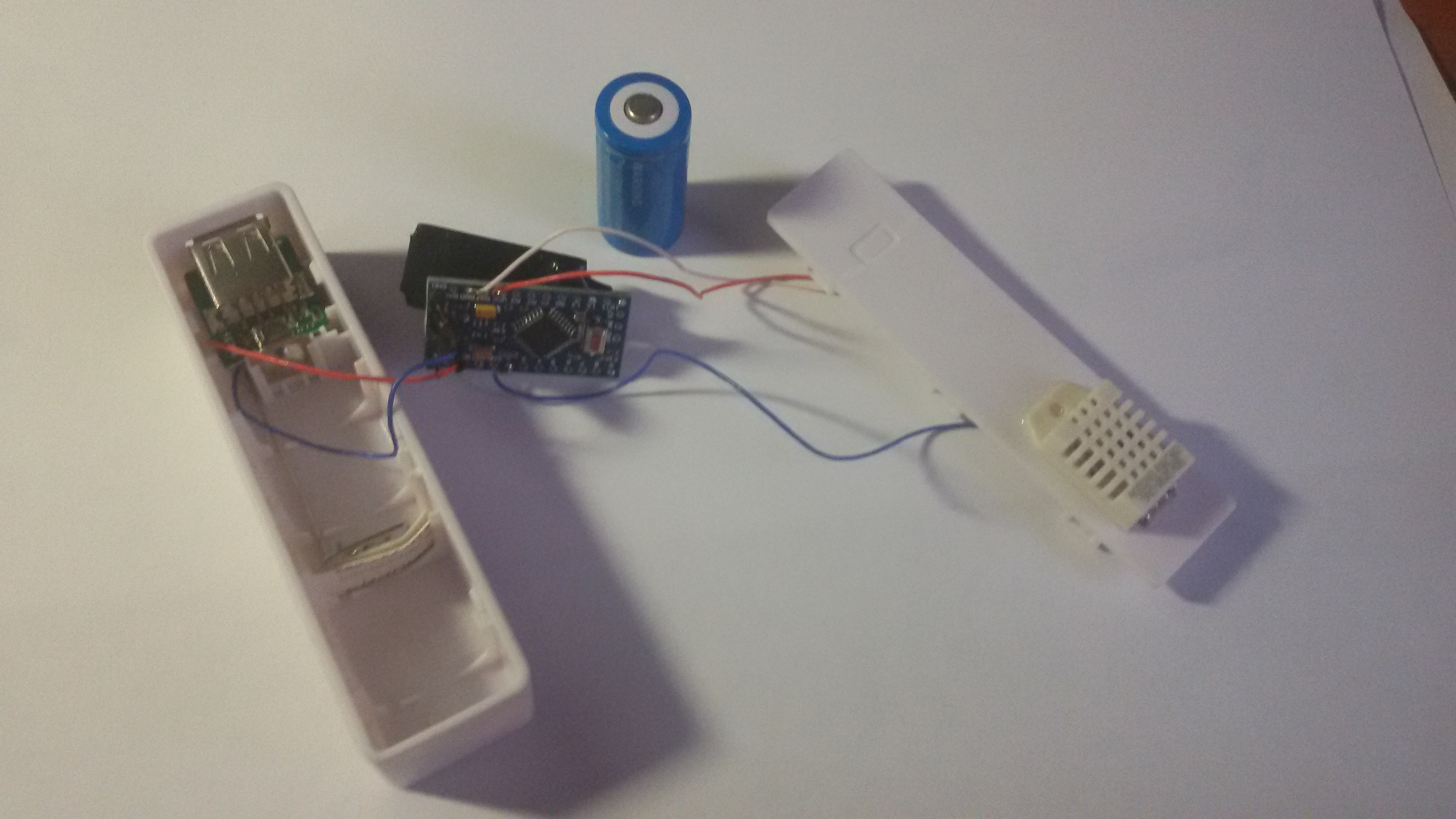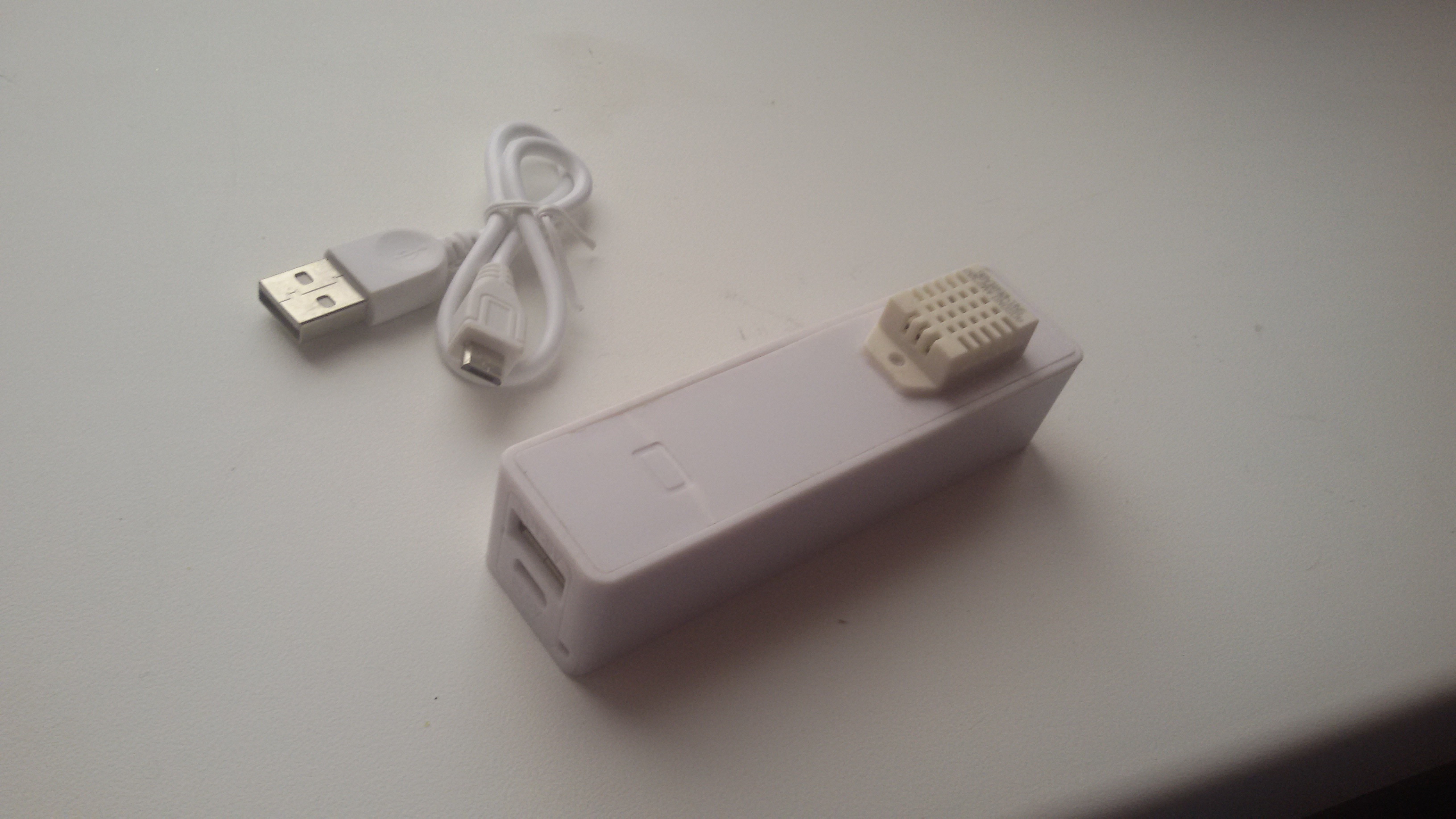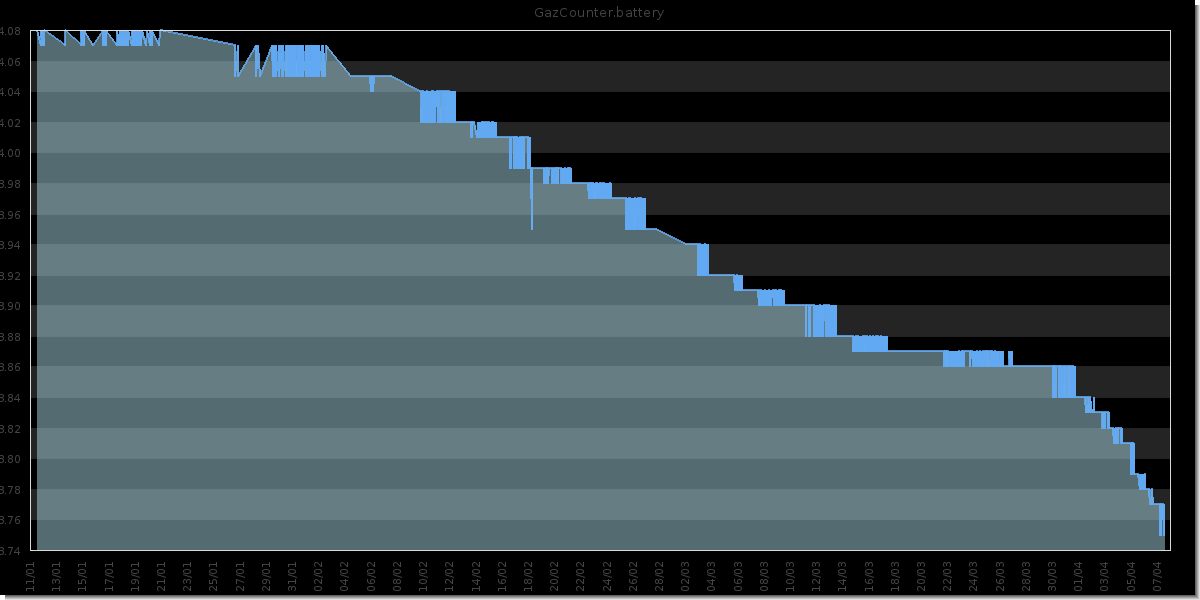Minimal design thoughts
-
-
Why do not use CR123A accumulator?
It is smaller and can be charged.
And not nide regulatorI use box with charger. With CR123A accumulator.
http://www.ebay.com/itm/2600Mah-USB-Portable-External-Battery-Charger-Power-Bank-for-Cell-Mobile-Phone-/301514424642?pt=LH_DefaultDomain_0&var=&hash=item4633a90142Very cheap


-
Why do not use CR123A accumulator?
It is smaller and can be charged.
And not nide regulatorI use box with charger. With CR123A accumulator.
http://www.ebay.com/itm/2600Mah-USB-Portable-External-Battery-Charger-Power-Bank-for-Cell-Mobile-Phone-/301514424642?pt=LH_DefaultDomain_0&var=&hash=item4633a90142Very cheap


-
CR123A in full charge has 4.07v
Gas counter started 2014/11/01.
In winter, temperatures drop below -10

-
You say that it don't need a regulator? the battery voltage is 4.07 when fully charged, that is 0.47V above the absolute maximum rating of the NRF24L01+, as it's only rated to 3.6V maximum. Same goes for the Si7021, maximum supply voltage is 3.6V.
So CR123A is not a good battery, unless you put a regulator in the loop, which then again uses current, and causes a voltage drop from battery supply
-
DHT22 = 3.3-6V DC
CR123A = 3.6v ( Bat full charge i have 4.07v )
NRF24L01+ = 3.6
I have 8 device and his work with CR123A for 6 months
When charge some device cannot translate packets, but after work -
DHT22 = 3.3-6V DC
CR123A = 3.6v ( Bat full charge i have 4.07v )
NRF24L01+ = 3.6
I have 8 device and his work with CR123A for 6 months
When charge some device cannot translate packets, but after work@Ivan-Z I think you are lucky... I burned a few radio's with a similar setup (with LiPO solar charger) I like your minimal design. If you replace the DHT sensor with a htu21 you can make it even smaller. There are a few htu21d boards with a 3.3v regulator on it which you could use to power the radio.
-
@AWI
What regulator do you use?I do not use the regulator because it has a extremeconsumption
AMS1117-3.3 = 5~10mV in idle@Ivan-Z I use the XC6206 series regulator. most of the times. The quiescent current for this one is very low 1-3 uA. This regulator is used by many of the sensor board suppliers to supply sensors with 3.3v Eg. In many cases (eg Adafruit) you can use the board as a "3.3v power supply"
-
Hi guys. I'm waiting for your board!
the only concern is about the 2xAA batteries adoption that could increase the overall size of a sensor node to a "normal node" size ( http://www.seeedstudio.com/depot/s/devduino.html?search_in_description=0).
I would like a stack as following: battery+board+radio. with the same footprint of the radio module.
The battery could be a CR123 with regulator, and the holder could be a pcb holder as this: http://www.memoryprotectiondevices.com/datasheets/BH-CR2-PC-datasheet.pdf
I actually ordered some of these: http://www.elecrow.com/devduino-sensor-node-v4-atmega-328-p-1201.html, at this moment the closest to my size requirements.
What do you think.? -
Hi guys. I'm waiting for your board!
the only concern is about the 2xAA batteries adoption that could increase the overall size of a sensor node to a "normal node" size ( http://www.seeedstudio.com/depot/s/devduino.html?search_in_description=0).
I would like a stack as following: battery+board+radio. with the same footprint of the radio module.
The battery could be a CR123 with regulator, and the holder could be a pcb holder as this: http://www.memoryprotectiondevices.com/datasheets/BH-CR2-PC-datasheet.pdf
I actually ordered some of these: http://www.elecrow.com/devduino-sensor-node-v4-atmega-328-p-1201.html, at this moment the closest to my size requirements.
What do you think.?@Roberto-Brunialti I am looking forward to this board also. I deployed a few Devduino V4's. These are really well built but lack the "minimal" size, have only a few connectors (enough in most cases as a good temp/hum sensor is on board).. And "restrict" you to the use of non-rechargable CR123 cells (3V,no regulator). I will love the very small footprint combined with the flexibility in power sources (and extra features) in the "Minimal design thoughts" design. :heart_eyes:
-
Think we should rename the thread to "Mysensors Micro" as this is the new name, since it's the first "official" board from mysensors.
Anyway, just got a couple of pictures from the factory in China, they have build the first batch of 5 pcb's that they are verifying at the moment, and then they should be shipped to us (either @hek or me?) and then we need to verify it, before giving a go on the production.
So we are comming closer to a "launch" of the device.
-
Think we should rename the thread to "Mysensors Micro" as this is the new name, since it's the first "official" board from mysensors.
Anyway, just got a couple of pictures from the factory in China, they have build the first batch of 5 pcb's that they are verifying at the moment, and then they should be shipped to us (either @hek or me?) and then we need to verify it, before giving a go on the production.
So we are comming closer to a "launch" of the device.
Yep, might also be good to create a new thread in Announcement when it has been launched (and is for sale) with a back-reference here for history/design decisions made by you.
I should probably start working on a more complete page on the main site with more details and illustrations.
-
In your design, C3, the nrf 4u7 capacitor, is a classic ceramic capacitor. In the mysensors tutorial, they write a polarized capacitor is better for the NRF. I use tantalum capacitor wich are bigger but is there a difference with the ceramic one for the nrf. I would like to use a ceramic 0603 too if there is no difference for nrf.
Thank's
-
will it be possible to use this board pcb without soldering the sensor , flash and security chip?
-
Any good news about the d-day (delivery day :smiley: ) ?
